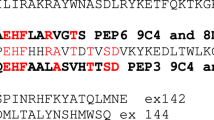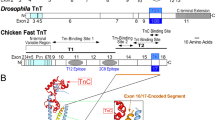Summary
The entire gene coding for the human β-myosin heavy chain has been isolated from genomic EMBL3A phage libraries by chromosomal walking starting from clone gMHC-1, reported earlier (Appelhans and Vosberg 1983). gMHC-1 has been shown to carry coding information for the C-terminal two-thirds of β-myosin heavy chain, which is expressed in cardiac muscle and in slow skeletal muscle fibers (Lichter et al. 1986). Three DNA clones were identified as overlapping with gMHC-1 by restriction mapping and DNA sequencing. They span a 30-kb region in the genome. About 22 kb extend from the initiation codon ATG to the poly(A) addition site. The clones include about 4 kb of 5′ flanking sequences upstream of the promoter. Comparisons of β- and α-myosin heavy chain sequences indicate that gene duplication of the cardiac myosin heavy chain isogenes preceded the mammalian species differentiation.
Access this article
We’re sorry, something doesn't seem to be working properly.
Please try refreshing the page. If that doesn't work, please contact support so we can address the problem.
Similar content being viewed by others
References
Appelhans H, Vosberg HP (1983) Characterization of a human genomic DNA fragment coding for a myosin heavy chain. Hum Genet 65:198–203
Bandman E (1985) Myosin isozyme transitions in muscle development, maturation, and disease. Int Rev Cytol 97:97–131
Bandman E, Matsuda R, Strohman RC (1982) Myosin heavy chains from two different adult fasttwitch muscles have different peptide maps but identical mRNAs. Cell 29:645–650
Benton WD, Davis RW (1977) Screening λgt recombinant clones by hybridization to single plaques in situ. Science 196:180–182
Blau HM, Pavlath GK, Hardeman EC, Chiu CP, Silberstein L, Webster SG, Miller SC, Webster C (1985) Plasticity of the differentiated state. Science 230:758–766
Bouvagnet P, Leger J, Pons F, Dechesne C, Leger JJ (1984) Fiber types and myosin types in human atrial and ventricular myocardium: an anatomical description. Circ Res 55:794–804
Breitbart RE, Andreadis A, Nadal-Ginard B (1987) Alternative splicing: an ubiquitous mechanism for the generation of multiple protein isoforms from single genes. Annu Rev Biochem 56:467–495
Buckingham ME (1985) Actin and myosin multigene families: their expression during the formation of skeletal muscle. Essays Biochem 20:77–109
Butler-Browne GS, Whalen RG (1984) Myosin isozyme transitions occurring during the postnatal development of the rat soleus muscle. Dev Biol 102:324–334
Buttrick PM, Malhotra A, Brodman R, McDermott L, Lam L (1986) Myosin isoenzyme distribution in overloaded human atrial tissue. Circulation 74:477–483
Caplan AI, Fiszman MY, Eppenberger HM (1983) Molecular and cell isoforms during development. Science 221:921–927
Caruthers MH, Barone AD, Beaucage SL, Dodds DR, Fisher EF, McBride LJ, Matteucci M, Stabinsky Z, Tang J-Y (1987) Chemical synthesis of deoxyoligonucleotides by the phosphoramidite method. Methods Enzymol 154:287–313
Catanzaro DF, Morris BJ (1986) Human cardiac myosin heavy chain genes. Isolation of a genomic DNA clone and its characterization and of a second unique clone also present in the human genome. Circ Res 59:655–662
Clarke L, Carbon J (1976) A colony bank containing synthetic ColE1 hybrid plasmids representative of the entire E. coli genome. Cell 9:91–99
Ecob-Prince MS, Jenkison M, Butler-Browne GS, Whalen RG (1986) Neonatal and adult myosin heavy chain isoforms in a nerve-muscle culture system. J Cell Biol 103:995–1005
Edwards YH, Parker M, Povey S, West LF, Parrington MJ, Solomon E (1985) Human myosin heavy chain genes assigned to chromosome 17 using a human cDNA clone as a probe. Ann Hum Genet 49:101–109
Emerson CP, Bernstein SI (1987) Molecular genetics of myosin. Annu Rev Biochem 56:695–726
Everett AW, Umeda PK, Sinha AM, Rabinowitz M, Zak R (1986) Expression of myosin heavy chains during thyroid hormone-induced cardiac growth. Fed Proc 45:2568–2572
Feinberg AP, Vogelstein B (1983) A technique for radiolabeling DNA restriction endonuclease fragments to high specific activity. Anal Biochem 132:6–13
Friedman DJ, Umeda PK, Sinha AM, Hsu HJ, Jakovcic S, Rabinowitz M (1984) Characterization of genomic clones specifying rabbit α- and β-ventricular myosin heavy chains. Proc Natl Acad Sci USA 81:3044–3048
Frischauf AM, Lehrach H, Poustka A, Murray N (1983) Lambda replacement vectors carrying polylinker sequences. J Mol Biol 170: 827–842
Harbarth P, Vosberg HP (1988) Enzymatic amplification of myosin heavy chain mRNA sequences in vitro. DNA 7:297–306
Hiller G (1986) Lokalisierung des menschlichen beta-Myosingens auf Chromosom 14 und die Identifizierung von zwei mit diesem Gen gekoppelten Restriktionsfragmentlängenpolymorphismen. Thesis, University of Heidelberg
Hoffmann U, Axman C, Grisk A (1986) Myosin isoenzymes in normal and hypertrophied human hearts. Biomed Biochim Acta 45: 985–996
Horstmann-Herold U, Lichter P, Mommaerts WFHM, Vosberg H-P (1988) Regulation of the human β-myosin heavy chain gene. In: Carraro U (ed) Sarcomeric and non-sarcomeric muscles: basic and applied research prospects for the 90s. Unipress, Padova (in press)
Izumo S, Nadal-Ginard B, Mahdavi V (1986) All members of the MHC multigene family respond to thyroid hormone in a highly tissue-specific manner. Science 231:597–600
Jandreski MA, Liew CC (1987) Construction of a human ventricular cDNA library and characterization of a beta myosin heavy chain cDNA clone. Hum Genet 76:47–53
Jandreski MA, Sole MJ, Liew CC (1987) Two different forms of beta myosin heavy chain are expressed in human striated muscle. Hum Genet 76:127–131
Karn J, Brenner S, Barnett L, Cesarini G (1980) Novel bacteriophage cloning vector. Proc Natl Acad Sci USA 77:5172–5176
Kozak M (1984) Compilation and analysis of sequences upstream from the translational start site in eukaryotic mRNAs. Nucleic Acids Res 12:857–872
Leinwand LA, Saez L, McNally E, Nadal-Ginard B (1983a) Isolation and characterization of human myosin heavy chain genes. Proc Natl Acad Sci USA 80:3719–3720
Leinwand LA, Fournier REK, Nadal-Ginard B, Shows TB (1983b) Multigene family for sarcomeric myosin heavy chain in mouse and human DNA: localization on a single chromosome. Science 221: 766–768
Lichter P (1986) Struktur und Expression genomischer Information für die schwere Kette eines menschlichen Myosins. Thesis, University of Heidelberg
Lichter P, Umeda PK, Levin JE, Vosberg HP (1986) Partial characterization of the human β-myosin heavy-chain gene which is expressed in heart and skeletal muscle. Eur J Biochem 160:419–426
Maniatis T, Fritsch EF, Sambrook J (eds) (1982) Molecular cloning: a laboratory manual. Cold Spring Harbor Laboratory, Cold Spring Harbor, NY
Matsuoka R, Chambers A, Kimura M, Kanda N, Bruns G, Yoshida M, Takao A (1988) Molecular cloning and chromosomal localization of a gene for human cardiac myosin heavy-chain. Am J Med Genet 29:369–376
Maxam A, Gilbert W (1980) Sequencing end-labelled DNA with base specific chemical cleavage. Methods Enzymol 65:499–560
McDermott P, Daood M, Klein I (1985) Controction regulates myosin synthesis and myosin content of cultured heart cells. Am J Physiol 249:H763-H769
Molina MI, Kropp KE, Gulick J, Robbins J (1987) The sequence of an embryonic myosin heavy chain gene and isolation of its corresponding cDNA. J Biol Chem 262:6478–6488
Mommaerts WFHM (1988) Fritz Lipman, a few personal memories, and: what else came out of the high-energy phosphate bond? In: Kleinkauf H, Döhren FR von, Jaenicke L (eds) The roots of modern biochemistry. de Gruyter, Berlin New York, pp 423–429
Nguyen HT, Gubits RM, Wydro RM, Nadal-Ginard B (1982) Sarcomeric myosin heavy chain is coded by a highly conserved multigene family. Proc Natl Acad Sci USA 79:5230–5234
Pette D, Vrbova G (1985) Neural control of phenotype expression in mammalian muscle fibers. Muscle Nerve 8:676–689
Rappold GA, Vosberg HP (1983) Chromosomal localization of a human myosin heavy chain gene by in situ hybridization. Hum Genet 65:195–197
Saez LJ, Leinwand LA (1986) Characterization of diverse forms of myosin heavy chain expressed in adult human skeletal muscle. Nucleic Acids Res 14:2951–2969
Saez LJ, Gianola KM, McNally EM, Feghali R, Eddy R, Shows TB, Leinwand LA (1987) Human cardiac myosin heavy chain genes and their linkage in the genome. Nucleic Acids Res 15:5443–5459
Sanger F, Nicklen S, Coulson AR (1977) DNA sequencing with chain termination inhibitors. Proc Natl Acad Sci USA 74:5463–5467
Silhavy TJ, Berman ML, Enquist LW (1984) Experiments with gene fusions. Cold Spring Habor Laboratory, Cold Spring Habor, NY
Southern EM (1975) Detection of specific sequences among DNA fragments separated by gei electrophoresis. J Mol Biol 98:503–517
Strehler EE, Strehler-Page MA, Perriard JC, Periasamy M, Nadal-Ginard B (1986) Complete nucleotide and encoded amino acid sequence of a mammalian myosin heavy chain gene — evidence against intron-dependent evolution of the rod. J Mol Biol 190: 291–317
Tsuchimochi H, Kuro-o M, Koyama H, Kurabayashi M, Sugi M, Takaku F, Furuta S, Yazaki Y (1988) Heterogeneity of β-type myosin isozymes in the human heart and regulational mechanisms in their expression. Immunohistochemical study using monoclonal antibodies. J Clin Invest 81:110–118
Warrick HM, Spudich JA (1987) Myosin structure and function in cell motility. Annu Rev Cell Biol 3:379–421
Weydert A, Daubas P, Caravatti M, Minty A, Bugaisky G, Cohen A, Robert B, Buckingham ME (1983) Sequential accumulation of mRNAs encoding different myosin heavy chain isoforms during skeletal muscle development in vivo detected with a recombinant plasmid identified as coding for an adult fast myosin heavy chain from mouse skeletal muscle. J Biol Chem 258:13867–13874
Whalen RG, Toutant M, Butler-Browne GS, Watkins SC (1985) Hereditary pituitary dwarfism in mice affects skeletal and cardiac myosin isozyme transitions differently. J Cell Biol 101:603–609
Author information
Authors and Affiliations
Rights and permissions
About this article
Cite this article
Diederich, K.W., Eisele, I., Ried, T. et al. Isolation and characterization of the complete human β-myosin heavy chain gene. Hum Genet 81, 214–220 (1989). https://doi.org/10.1007/BF00278991
Received:
Accepted:
Issue Date:
DOI: https://doi.org/10.1007/BF00278991




